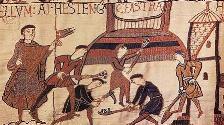![]() From
Caen to Hastings
From
Caen to Hastings
The town of Caen in Normandy was one
of Duke Williamís principal bases where he built a huge castle and two
monasteries. Williamís preparations for war made not far away on the banks
of the River Dives are vividly shown on the Bayeux Tapestry. In his army
William had his own followers alongside groups of mercenary knights, many of
whom were Breton, Flemish and French. They were trained to fight on foot and,
unlike the English, on horseback.  They were also skilled in building what are
known as known as motte and bailey castles; the motte being an earthen mound
with a tower or keep on top and the bailey a defended area in which there were
dwellings and storehouses.
They were also skilled in building what are
known as known as motte and bailey castles; the motte being an earthen mound
with a tower or keep on top and the bailey a defended area in which there were
dwellings and storehouses.
William set out in early September, but bad weather in the Channel forced him to take refuge at St Valery at the mouth of the River Somme. On receiving a fair wind the Normans embarked on 27th September and landed unopposed in Pevensey Bay near Hastings. William occupied and strengthened the old Roman fort. On the 29th September he moved to Hastings where he quickly built a castle.